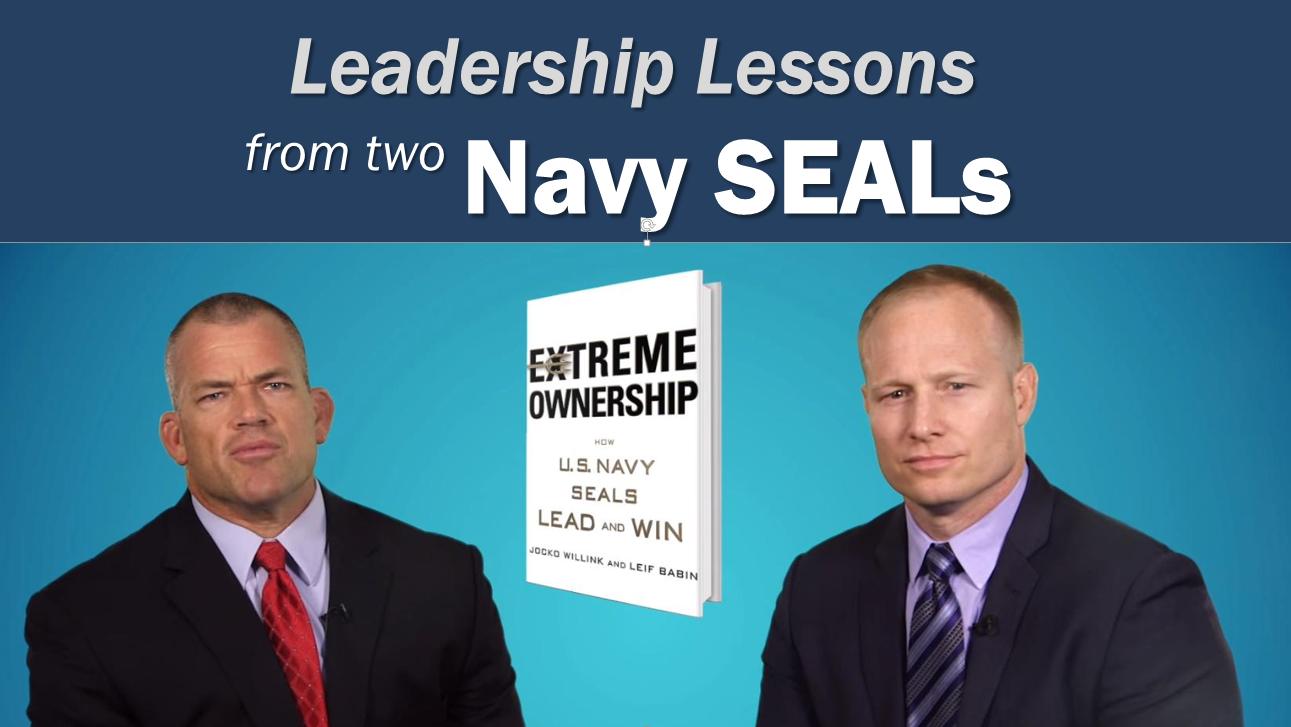It is not easy to find a truly good leadership book. Two of the best I have found bring lessons from the military: Lead like Ike, and Turn the Ship Around. Maybe it is because they deal with life-and-death situations, or maybe because there are clear missions with no ambiguity over who won and who lost.
Navy SEALs are some of the highest-performing military teams in the World. Jocko Willink and Leif Babin are retired Navy Seal officers who fought in Iraq. This posts covers 10 leadership lessons from their book, Extreme Ownership. The core idea is that leadership is based in clarity, trust and accountability.
I listened to the audio book version. In the last five years I have gone to maybe 200 audio books, most of which I probably would not have read otherwise. I don’t listen to music in my car anymore. It is one of the best investments I have made. I recommend you give Audible a try.
Here are the 10 Leadership Lessons from Navy SEALs Jocko Willink and Leif Babin:
1. Leaders Embrace Extreme Ownership
Extreme Ownership is the most important concept of this book, and it threads across the other lessons. It is a concept I have written about before in a post titled There are no Excuses, the Ball is in Your Court. And is one that we should apply to the business world. You can’t blame your products, your boss, your budget, the economy, competitors or your team for your success or failure. You are accountable for your success in your job, your career and your life.
A true leader owns the outcome. When things go wrong, you have to take ownership. No excuses.
“On any team, in any organization, all responsibility for success and failure rests with the leader. The leader must own everything in his or her world. There is no one else to blame. The leader must acknowledge mistakes and admit failures, take ownership of them, and develop a plan to win.”
2. There Are No Bad Teams, Only Bad Leaders.
Good leadership is contagious. Leaders transform people and their ability to get things done. They create a culture of accountability and teamwork, of winning and how to win, in every individual. Mutual accountability means each member demands the highest performance from the others and each individual knows what they need to do to win and they do it.
“Leadership is the single greatest factor in any team’s performance. Whether a team succeeds or fails is all up to the leader. The leader’s attitude sets the tone for the entire team. The leader drives performance- or doesn’t.”
3. Mission Clarity.
Everyone on the team must understand not only what do to, but why. Leaders don’t have to explain every decision but they need to communicate the strategic picture and the mission. Let the team ask questions. The leader is responsible to have everyone on the team believing in the mission and clear on the objectives.
“Actions and words reflect belief with a clear confidence and self-assuredness that is not possible when belief is in doubt.”
4. Keep Your Ego in Check.
Leaders put the mission above their personal needs and their personal ego. Leaders display humility. They accept the best ideas, even when they come from the ranks. Leaders take full ownership when they make a mistake and change direction.
“Ego clouds and disrupts everything: the planning process, the ability to take good advice, and the ability to accept constructive criticism.”
5. Act Decisively. Cover and Move.
You will never get to 100% certainty. Wait and see means deciding not to decide. The picture will never be complete, there is always risk, there is no absolute right solution. Therefore, you cover your risks, and move forward. Leaders acknowledge uncertainty, mitigate risks and continue advancing towards achieving the mission. Navy SEAL leaders have a bias for action.
“In the seal teams we taught teams to act decisively, my default setting should be aggressive. Proactive rather than reactive. Instead of the situation dictating our decisions, we dictated the situation. “
6. Simplicity and Clarity.
Complexity is the enemy. Complexity usually means there are many unknowns and that the team has too many variables to work on. A complex problem requires a complex plan which is not easily understood and not easily executed.
Leaders start by solving the simpler problems, and continue taking on bigger challenges as they progress. Leaders eliminate complexity in problems and in situations. Leaders bring clarity to a situation. They keep plans simple, clear, and concise.
7. Prioritize and Execute.
When leaders find themselves in a situation where multiple issues require their attention it is easy to fall in despair. Good leaders identify the highest priorities and tackle problems one at a time. The best leaders stay a step or two ahead of problems. Their foresight allows them to anticipate issues and to begin to solve them before they become bigger problems.
“Even the most competent of leaders can be overwhelmed if they try to tackle multiple problems or a number of tasks simultaneously. The team will likely fail at each of those tasks. Instead, leaders must determine the highest priority task and execute. Prioritize and Execute.”
8. Decentralized Command.
Good leaders delegate. They trust their teams to execute. They provide freedom to execute by giving them clarity in the mission and clear boundaries.
In the military, there is a concept called Commander’s Intent. The leader provides a very clear goal, he communicates what needs to be accomplished. The team has freedom to determine the best way how the goal will be accomplished. This gives the team the much needed freedom to innovate and adapt as the situation changes.
“The best teams employ constant analysis of their tactics and measure their effectiveness so that they can adapt their methods and implement lessons learned for future missions.”
9. Manage Up and Manage Down.
Good leaders manage up the chain of command. They understand the perspective of their commanders. They ask questions. They provide information and build confidence. Engage with your higher-ups; keep them in the loop–especially when they frustrate you. Leading down the chain of command means being able to convey the overall strategic mission to everyone downstream, while also giving people ownership of certain decisions, which leads to higher buy-in.
“If your boss isn’t making a decision in a timely manner or providing necessary support for you and your team, don’t blame the boss. First, blame yourself. Examine what you can do to better convey the critical information for decision to be made and support allocated.”
10. Discipline Equals Freedom.
Discipline is the most important quality for an individual and for a team. Discipline is a matter of personal will. It’s the difference between being good and being exceptional. “The best seals I worked with were invariably the most disciplined. They woke up early, they worked out every day, they studied, they practiced. Just as an individual excels when he or she exercises self-discipline, a unit that has tighter and more disciplined procedures and processes will excel and win.“
Discipline does not make a team more rigid, but more flexible. How? By creating processes and systems that allow teams to execute in different conditions without having to re-think the basics. The essential processes are covered by discipline. The mind then is free to focus on what is important in the moment.
“Instead of making us more rigid and unable to improvise, this discipline actually made us more flexible, more adaptable, and more efficient. It allowed us to be creative . When we wanted to change plans midstream on an operation we didn’t have to recreate an entire plan. We had the freedom to work within the framework of our disciplined procedures.”
The Dichotomy of Leadership
Leadership requires a balance between seemingly opposite traits:
- Must lead but also be able to follow, putting aside ego to follow better ideas and those who take charge.
- Calm, but not robotic.Logical but not devoid of emotions. Team members must know Leaders care. Leaders who lose temper, also lose respect. People do not follow robots.
- Brave but not reckless. Mitigate those risks that can be controlled.
- Aggressive but not overbearing. Courageous but not foolhardy. Strong but also with physical and mental endurance.
- Close with subordinates but not too close. Know their people and their motivations. But not so close than one member becomes more important than another, more important than the mission.
- Confident but never cocky. Confidence is contagious. Overconfidence causes complacency and arrogance.
- Have a competitive spirit but also be a gracious loser. Push the team to perform at the highest levels but never put their own drive for personal success above mission success.
- Attentive to details but not obsessed by them. A good leader does not get bogged down in the minutia of a tactical problem at the expense of strategic success.
- Quiet but not silent. Speak up when it matters.
- Competitive but a gracious loser. Recognize limitations. Admit mistakes and take ownership of mistakes.
- Humble but not passive. Act with professionalism and recognize others for their contributions. The leader is in charge. Able to execute extreme ownership while exercising de-centralized command.
If you liked this post, let me suggest another good one: Flip the Org Chart – 5 Qualities of Great Managers. And If you like this summary you should consider getting the book: Extreme Ownership: How U.S. Navy Seals lead and Win. It is destined to be a classic.

